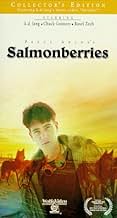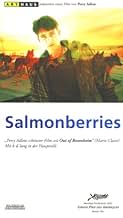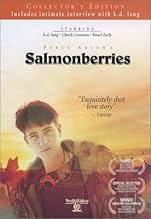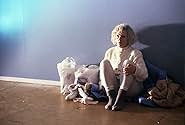अपनी भाषा में प्लॉट जोड़ेंA woman who grew up in a small town in Alaska goes to the public library to try and find out who her parents were. She was brought to town as a baby in a cardboard box with "Kotzebue" on it,... सभी पढ़ेंA woman who grew up in a small town in Alaska goes to the public library to try and find out who her parents were. She was brought to town as a baby in a cardboard box with "Kotzebue" on it, which is the name of the town and also the name of the family that founded the town. She ... सभी पढ़ेंA woman who grew up in a small town in Alaska goes to the public library to try and find out who her parents were. She was brought to town as a baby in a cardboard box with "Kotzebue" on it, which is the name of the town and also the name of the family that founded the town. She eventually befriends the librarian, an East German immigrant who lost her husband while es... सभी पढ़ें
- पुरस्कार
- कुल 3 जीत
फ़ीचर्ड समीक्षाएं
There are two very interesting and totally un-stereotypical main characters, which I both like very much in spite of their (or because of their?) quirkiness. They are played very well by k.d. lang and Rosel Zech. They both have interesting and touching life stories that are slowly revealed throughout the film. Both the revealing of their stories and the development of their unique relationship keeps you guessing where the film will go and keeps you interested.
The story itself is helped a lot through other things like the extraordinarily beautiful imagery of the film. The Alaska scenery is stunning but never cheesy. And anyone who ever saw this film will ever forget the image of Switha's bedroom with the sunlight shining through the glasses with the berries.
On top of that comes the equally beautiful and haunting song "Barefoot" sung by k.d. lang herself. It's amazing how you can hear how much the film inspired her as a singer and songwriter in the recording.
I honestly recommend to buy the DVD - also because in the Extras, there is a great interview, well it's more like a meeting, where director Percy Adlon meets with k.d. lang 11 years later and shares memories. Again, in k.d.'s thoughtful and insightful comments you see what an emotional film this was to produce.
I honestly can't imagine how anyone can find this film weak or boring. Of course there are minor flaws - Kotzebue's too sudden and strong change of character when they visit Berlin is the most obvious one - but this film always strikes a chord in me.
I'm giving it a 2/10 simply because I was able to finish the movie, and because I've seen worse. But make no mistake... This movie is quite bad. And not even in a funny way. I was having a hard time even picking a rating for this movie. It's kind of like watching an instructional video for your new Singer sewing machine- it's not really something that you rate. It just kind of... Exists.
Take the example of the character of Roswitha's German brother: we are told he is deaf. Yet he speaks; literally and more with his nervous hands, his mournful attentive stance, they all speak volumes. It is not acting you spot but the deft, confident direction.
k d lang's theme song "Barefoot" is haunting and the more you hear it, it grows on you. But her performance did not evoke much response in me. I do not consider her performance to be great by any standards.
However Rosel Zech as Roswitha is pleasure to watch as she blooms from a cold person to a warm personality in the course of the film. Zech and Adlon have contributed much to the film as did Conrad Gonzales' editing. Gonzales and Adlon together have made electricity come alive on celluloid--electricity goes off during crucial scenes, electric neon lights buzz, electric surges in voltages create capture enigmatic scenes as still life...
Adlon's exteriors are predictably white; his interiors are dark, both in Alaska and in Germany. But there are brief moments when the dark interiors become white like a ritual, in a baptism of sorts.
Adlon's choice of actors intrigued me including the casting of Chuck Connors and k d lang. Why did he choose to make this film? What was the basis of the "salmonberries" storyline? Was it a book? It reminded me of Kurosawa making "Derzu Uzala" in old USSR. Both movies asked questions about roots of characters. Only Kurosawa was much better of the two. This is my first Adlon film but he has made me take note of a very distinct style of direction that cannot be ignored. Hollywood could learn a thing or two from this film which is so close to pristine European cinema.
There is an outer and an inner story in this movie. The outer story is the extraordinary and partly one-sided friendship by an androgynous native and the German librarian. This story is, frankly, mediocre. But much more important, it seems at least to me, is the inner story: Imagine you are 21 years exiled in Alaska and now you have suddenly the chance to fly to Berlin, your home-town, and exactly at the time when the East German Wall falls which kept you exiled for such a long time. When outer things collapse, then there is always the problem how your inner reacts, how you hold it back from also collapsing. I think this is what this movie is really about, and I also think that this is the reason, why the climax, the landing of the machine of Alaskan Airlines in Tempelhof, is prepared by the stunning beauty of the remote landscape of the former Air Force Station at the Arctic Sea. As long you are in asylum, you represent this asylum and if it be only for you alone. This is why Alaska is Germany, and, as we heard, not only for Roswitha. If you are not convinced that I am right, ask yourself about this short scene with the tightrope walker, or have you missed it? Shortly after the landing of "Kotz" and Roswitha in Berlin. - Nietzsche, Zarathustra, chapter 6, correct.
क्या आपको पता है
- गूफ़When the pickup arrives, it stops with its right front tire on a coil of wire when seen from above. Then when seen from the front the wire is under the truck and the wire returns to under the tire.
- क्रेज़ी क्रेडिटShortly before the end of the credits there is the following paragraph: 'No animals were killed exclusively for the production of this film. Furs were worn simply to depict the lifestyle of the native Inupiat culture.'
टॉप पसंद
- How long is Salmonberries?Alexa द्वारा संचालित
विवरण
- रिलीज़ की तारीख़
- कंट्री ऑफ़ ओरिजिन
- आधिकारिक साइट
- भाषा
- इस रूप में भी जाना जाता है
- Percy Adlon's Salmonberries
- फ़िल्माने की जगहें
- उत्पादन कंपनी
- IMDbPro पर और कंपनी क्रेडिट देखें
बॉक्स ऑफ़िस
- US और कनाडा में सकल
- $37,484
- दुनिया भर में सकल
- $37,484
- चलने की अवधि1 घंटा 35 मिनट
- रंग
- ध्वनि मिश्रण
- पक्ष अनुपात
- 1.66 : 1
इस पेज में योगदान दें


























